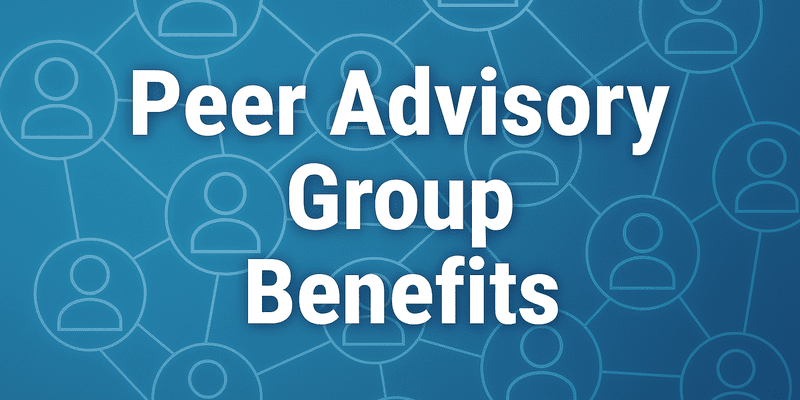Peer Advisory Group Benefits & the Future of Education in the Age of AI

Solutions Review Executive Editor Tim King wrote this short primer on peer advisory group benefits using the future of education in this AI moment as the lens.
Artificial Intelligence is changing the nature of learning faster than most institutions can adapt. We’re entering a world where AI can teach, test, summarize, and simulate — often faster and more accurately than human educators. But what AI cannot replicate is context, judgment, and shared human growth.
That’s where expert-led, peer advisory groups emerge not as a supplement to education, but as its successor framework — a human-centered model for continuous learning in an algorithmic age.
Why Human Intelligence Networks Might Define How We Learn Next
For centuries, education has been linear: teacher to student, textbook to test, credential to career. It was a one-way pipeline designed for an industrial world — predictable, hierarchical, and time-bound.
AI collapses that model. Knowledge is now instantly searchable, infinitely reproducible, and continuously updated. The “what” of education — information transfer — has been automated. The “how” and “why” of education — critical thinking, ethical reasoning, collaboration, creativity — are now what matter most.
And those cannot be taught effectively in isolation or through content alone. They require conversation, friction, and peer interaction.
The Return of Human-Centric Learning
In the early days of human civilization, learning happened in circles, not classrooms. People gathered to share experiences, debate, and reflect together. The philosopher’s symposium, the artisan’s guild, the rabbi’s circle — all were peer-based learning environments grounded in dialogue and discovery.
Peer advisory groups are the modern re-emergence of that model, reborn for an era where intelligence is abundant but wisdom is scarce.
Within a peer group, participants don’t memorize—they metabolize. They process new ideas through the lived realities of others. When AI systems can generate answers to any factual query, the next frontier of education is the collective interpretation of those answers.
Why Peer Groups Are a Potential Path
They Transform Knowledge into Application
AI can provide you with a thousand strategies, but only human peers can tell you which one actually worked in their organization last week. Peer groups move learning from abstraction to application, turning information into implementation.
They Restore Trust & Shared Context
In a world flooded with synthetic content, human-verified experience becomes the new gold standard. Peer advisory sessions filter out noise and rebuild trust through firsthand testimony — people showing what’s real, not what’s optimized for clicks.
They Foster Lifelong Community
AI is accelerating the half-life of knowledge. Degrees and certifications expire almost as soon as they’re earned. Peer groups create perpetual learning loops — dynamic ecosystems where professionals stay current, accountable, and supported as the world shifts beneath them.
They Develop Emotional and Relational Intelligence
Machines can mimic empathy but cannot experience it. Peer groups cultivate the emotional literacy required for leading humans in an AI-dominated workplace. Members learn to listen, discern, and lead with compassion — skills that will become more valuable than technical expertise alone.
They Anchor Human Agency in the AI Economy
The more decisions AI makes, the more humans must understand the moral, social, and strategic implications of those decisions. Peer networks become governance incubators — spaces where leaders stress-test ethical reasoning, challenge each other’s assumptions, and define human boundaries for intelligent systems.
From Classrooms to Circles
Universities and corporate training programs are already being disrupted by AI tutors, adaptive learning systems, and virtual classrooms. But as automation takes over content delivery, what remains distinctly human is interpretive learning — where meaning is co-created through dialogue.
Peer groups preserve that human essence. They ensure that as AI scales knowledge, humanity scales wisdom.
The next generation of education will not be a course; it will be a conversation. The most important credential won’t be a degree; it will be a network of trust — a living peer ecosystem you can rely on for real-world intelligence.
The Pedagogy of the Future
Imagine education not as a stack of credentials, but as a mesh network — a living web of peers who share, iterate, and grow together. Each node represents an individual’s experience; each connection, a transfer of insight.
That is the educational structure of the AI era: not vertical instruction but horizontal connection. It’s why communities like Insight Jam Mesh groups are emerging as vital supplements — and, increasingly, replacements — for traditional professional development.
In a Mesh group, you’re not a student but a contributor. The facilitator is not a lecturer but a guide. The curriculum is not a syllabus but a sequence of live challenges. Learning happens through collective reasoning — and that reasoning gets sharper each session.
Why This Matters Now
The coming decade will see the largest re-education wave in human history. Millions of professionals will need to reskill not once, but continually. Universities, HR departments, and online courses will all play roles — but none can match the agility, intimacy, or authenticity of small-group peer learning.
Peer advisory groups will become the connective tissue of the human intelligence economy — the place where workers evolve together in real time. They are the new universities of professional life.
Mesh as an Educational Model
We launched Insight Jam Mesh is a working prototype of this philosophy. Each group connects 8–10 professionals wrestling with similar challenges across industries — whether AI readiness, ethical governance, data transformation, or leadership adaptation.
Guided by an expert facilitator, the group becomes both a think tank and a classroom. Members share what’s working, troubleshoot what’s not, and design new approaches together. Over time, the group becomes a persistent learning organism — one that learns faster than any individual or algorithm could alone.
Note: These insights were informed through web research using advanced scraping techniques and generative AI tools. Solutions Review editors use a unique multi-prompt approach to extract targeted knowledge and optimize content for relevance and utility.



